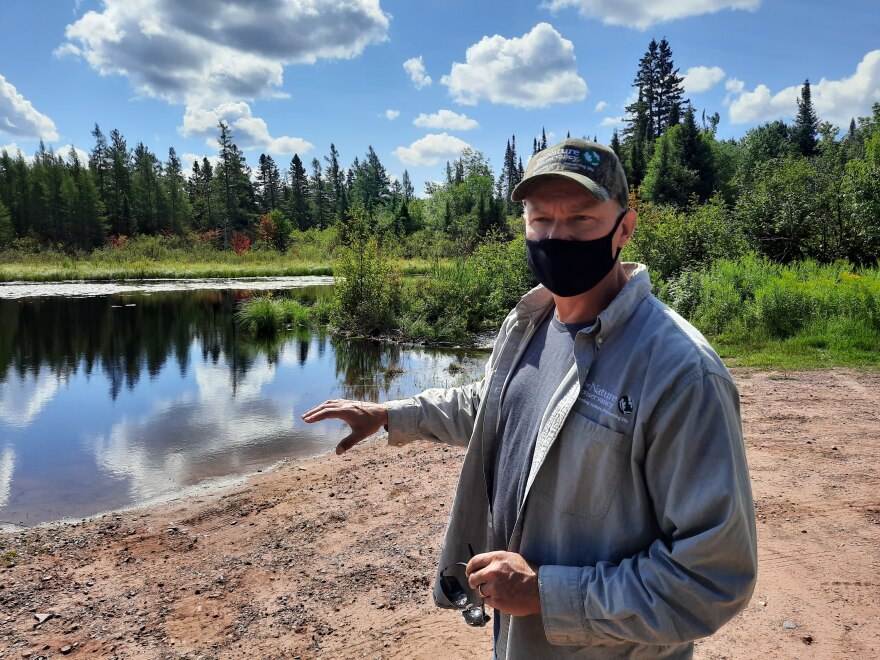Walking out onto a muskeg, or wetland, the first things most people notice are the sensation of sinking and sound of suction.
Saturated sphagnum moss, or peat moss, covers the wetland. It’s walkable, but only with knee boots on. Legs sink to calf-level. They’re buoyed by the moss, although water seeps in.
But upon arriving at this wetland in Iron County, Aaron Marti first noticed a different sensation.

“If you take a deep breath,” he said, “you can get a bit of a whiff of, it’s kind of a sweet, almost spicy aroma.”
That wetland smell takes Marti, now a DNR wetlands specialist, back to his Boy Scout days, learning about wetlands and feeding his interest in science.
He discovered this wetland near Caroline Lake a few years ago while doing research and loved its carpet of moss, interspersed tamarack trees, and diversity of species.
“When I came and saw this that fall, I thought, what an iconic picture,” he said. “I should send this to the tourism bureau or something like that.”

Before European settlement, about 30 percent of Wisconsin was covered by wetlands.
Over the decades, development, industry, and farming moved in, and only about 15 percent of those wetlands remain, including this one in Iron County.
Now, a new Trump administration rule means more than half of the wetlands left may no longer have federal protection. The rule has environmentalists worried about the fate of Wisconsin wetlands.

The wetlands near Caroline Lake span hundreds of acres, with plant species common to the landscape, like wild blueberry and cranberry.

Besides providing unique plant habitat, Wisconsin wetlands host countless animals, often including birds, beavers, muskrats, and even moose and bear.
They also act like giant sponges, holding and purifying water, said Matt Dallman, the Deputy State Director for The Nature Conservancy.
“When you get that four- to six- to eight-inch rains in 24 hours, it’s a critical function that wetlands play in being able to buffer that flood control,” he said, his boots sinking into the Iron County muskeg.

These wetlands drain into nearby Caroline Lake.
“Those wetlands are the sponge and the release so that we always have constant flow here,” Dallman said.

Dallman’s organization, The Nature Conservancy, protects more than 1,000 acres of land in this area, in part because of what flows out of Caroline Lake.
“You can hear that water rushing,” Dallman said at Caroline Lake’s simple boat landing. “That four-foot stream is the beginning of the Bad River.”
The Bad River flows north to Lake Superior, ending at the Kakogon/Bad River Sloughs, a Ramsar Wetland of International Importance.

Including the ones near Caroline Lake, wetlands define and influence major swaths of the state.
Nick Miller, the Director of Science and Strategy for The Nature Conservancy’s Wisconsin Chapter, calls the state “rich in wetlands.”
That’s true, even though millions of acres have disappeared over the years. Developers have filled them in to make room for business and industry. Farmers have drained them to increase area for crops.
While about 6.4 million acres of wetlands still cover Wisconsin, many are under threat, Miller said.
“There has been rollback and degradation, if you will, of those protections in recent times,” he said. “Case and point, where we’re seeing that is with the redefinition of what are Waters of the U.S.”
Under the 1972 Clean Water Act, the federal Waters of the United States rule (WOTUS) protects rivers, lakes, streams, and many wetlands from pollution, filling, and draining.
But the Trump administration has sought to narrow what falls under its definition and what gets federal protection.

“When President Trump took office, he immediately set in motion a process to remove and replace regulatory burdens that were stifling American innovation and economic development,” said Environmental Protection Agency Administrator Andrew Wheeler last year. “The Obama administration’s 2015 Waters of the U.S. definition was at the top of the list.”
The administration’s new WOTUS rule went into effect this year.
It removes multiple types of waters from protection. Wetlands without a constant and direct surface water connection to a larger river or lake are unprotected.
If the surface-water connection is only in the wet season, it’s unprotected. If the wetland is isolated, it’s unprotected. If the water connection is only underneath the surface, it’s unprotected.

The Nature Conservancy and Wisconsin's Green Fire estimate, under the new rule, 55 percent of remaining wetlands in Wisconsin will lose federal protection.
“We’ve already lost half, perhaps over half, of our state’s wetlands [in our history]. Now, we’re looking at rolling back federal protections so that another half are no longer federally protected,” Miller said.
Many wetlands in Wisconsin will retain state-level protection, but will lose the extra layer of federal protection. They may be more at risk of degradation or disappearance thanks to human activities.
“Northern Wisconsin could be more affected than southern Wisconsin because that’s just where we find not only the bulk of wetland coverage, big wetland systems, but it’s also where we find the types of wetlands that might no longer be defined as Waters of the U.S.,” Miller said.

Back out on the wetland near Caroline Lake, Aaron Marti’s boots sink into the sphagnum moss bed.
“If you pick up a handful of sphagnum moss and you squeeze it, it is almost like a sponge,” he said. “It’s quite amazing when you think about how much water is in something that looks like a ball of fluff.”
He’s standing in a place that has a long history.

“It takes tens of thousands of years for these ecosystems to form and come to fruition,” Marti said.
The Nature Conservancy’s Matt Dallman agrees.
Once wetlands are gone, they’re tough to get back.
“You can’t kid yourselves that we can replace this,” he said. “You can’t create that in any time within our lifetimes.”








